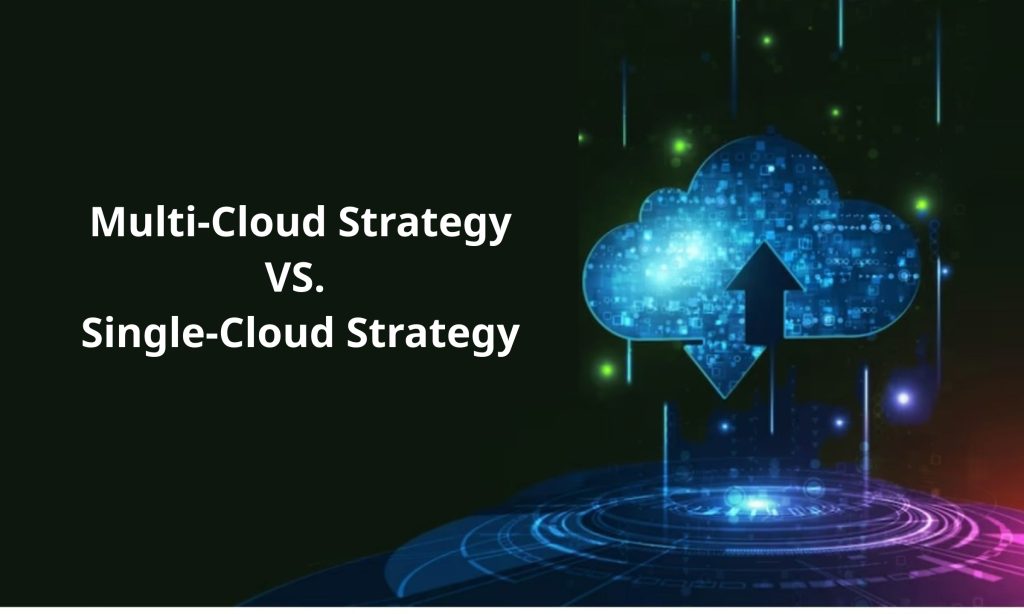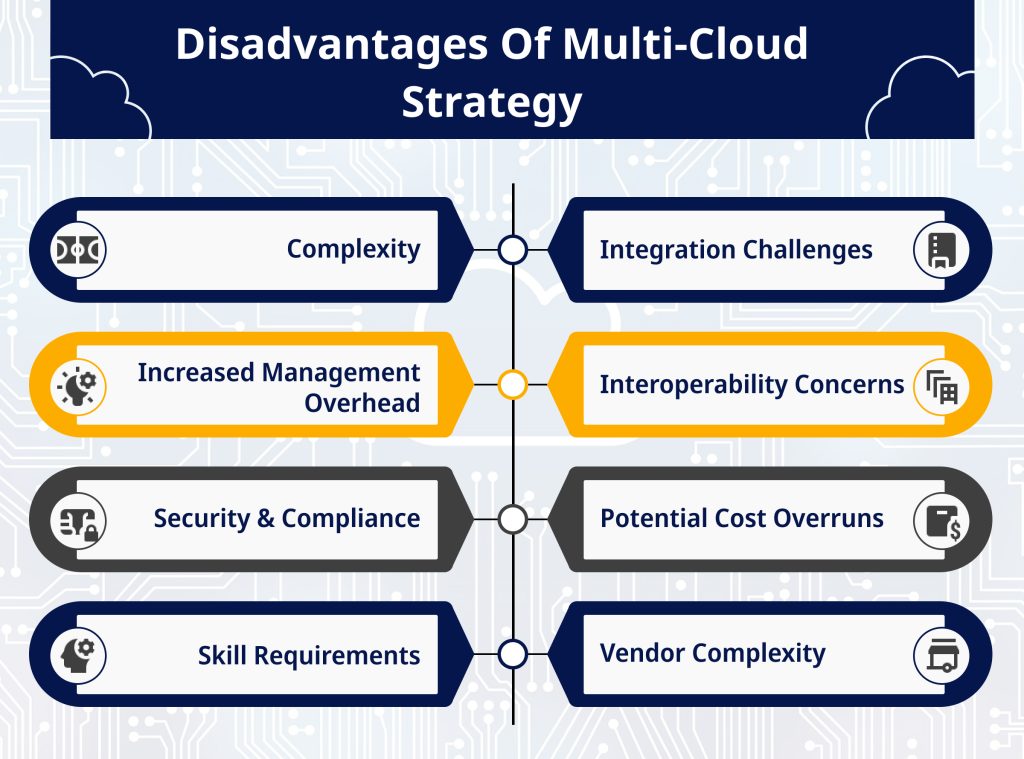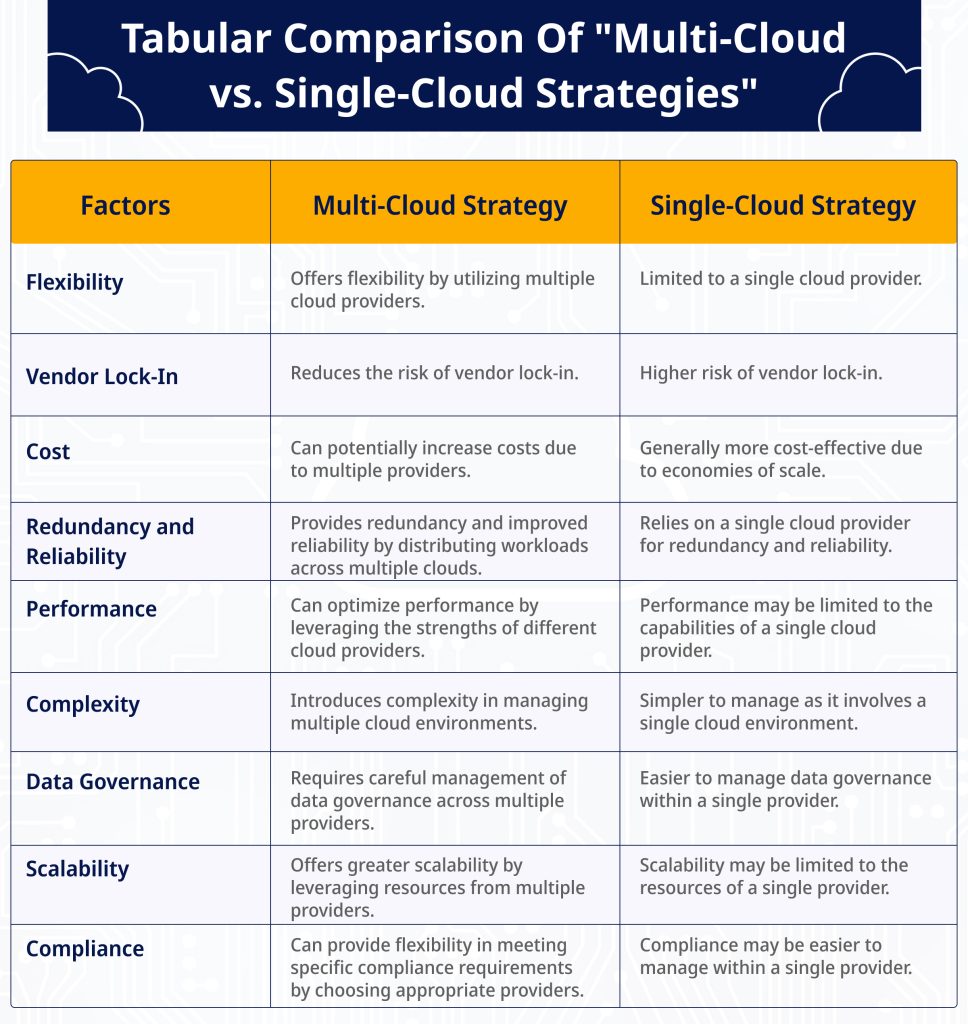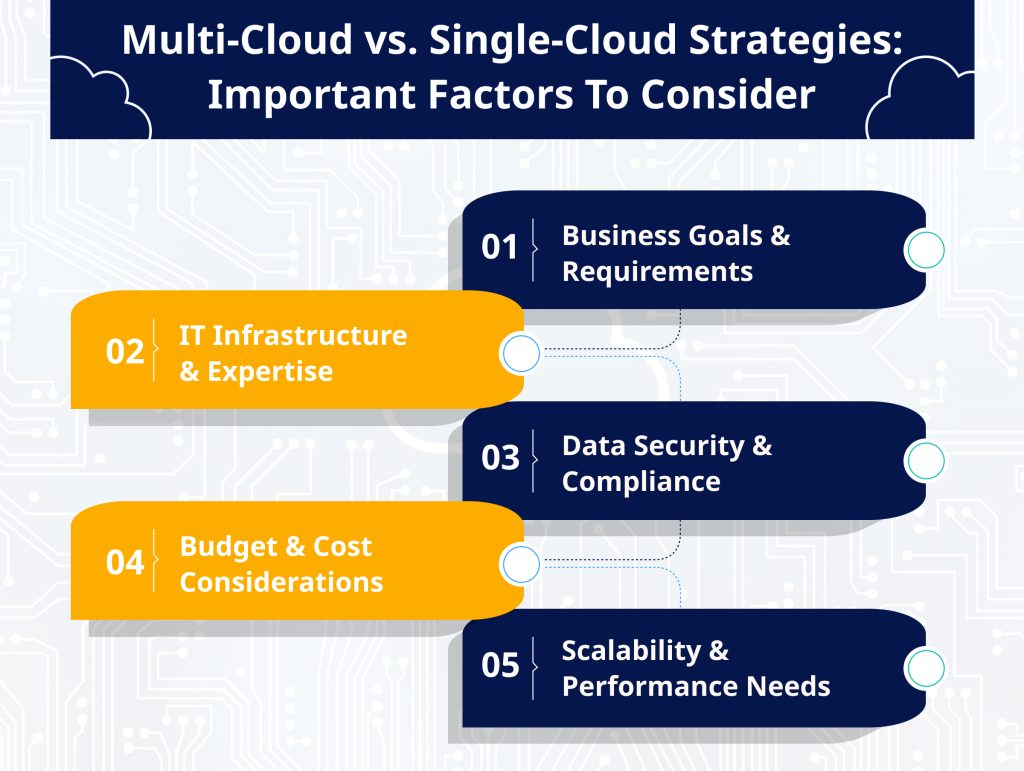If you own a business, you must be standing at a crossroads that could redefine this digital trajectory:
Should you embrace the versatility of a multi-cloud strategy or streamline operations using a single-cloud approach?
The choice between “multi-cloud vs single-cloud strategies” is tough and technical as both require a comprehensive understanding of a business’s unique needs, long-term goals, and existing infrastructure information.
This blog post explores the key differences between the above two approaches – “multi-cloud vs single-cloud” and helps you determine the right fit for your business.
So, let’s dive in and unravel the mysteries of Multi-Cloud vs. Single-Cloud strategies in current business operations.
Understanding Multi-Cloud & Single-Cloud Strategies
Multi-cloud and single-cloud strategies are two approaches that businesses can adopt when it comes to utilizing cloud providers for their computing needs.
Let’s delve into each strategy and explore the key differences between them:
Multi-Cloud Strategy
A multi-cloud strategy involves using multiple cloud providers to meet different business requirements. With this approach, a company leverages the services & capabilities of multiple cloud platforms simultaneously.
Have a look at this example:
A business can use Amazon Web Services for storage needs, Microsoft Azure for machine learning capabilities, and Google Cloud Platform for data analytics requirements.
- Businesses can mitigate the risk of dependence on a single provider by distributing workloads across different cloud providers.
- This strategy allows organizations to take advantage of each cloud platform’s unique features & strengths as it tailors their solutions to specific needs.
- This approach enhances resilience & redundancy, as workloads can be easily shifted between providers in case of outages or performance issues.
Single-Cloud Strategy
A single-cloud strategy involves relying on a single cloud provider for all computing needs. This approach typically entails using one cloud platform, such as AWS, Azure, or GCP, exclusively for hosting applications, storing data, and running various services.
- Businesses can streamline their operations & reduce complexity by focusing on a single provider.
- This approach could achieve cost savings through volume discounts or bundled services.
- Organizations can benefit from a consistent set of tools, APIs, and management interfaces offered by the chosen cloud provider.
- You can also hire AWS developers who can help you in simplifying development & deployment processes.
Key Differences in Cloud Provider Utilization
Choosing between a Multi-Cloud vs. Single-Cloud strategy depends on various factors:
While a multi-cloud strategy offers greater diversity & resilience, a single-cloud strategy provides simplicity and potential cost savings. Hence, businesses must carefully examine their needs & consider the advantages/trade-offs of each approach before making a decision.
The main difference between Multi-Cloud and Single-Cloud strategies is how cloud providers are utilized.
In a multi-cloud strategy, businesses leverage the strengths & capabilities of multiple providers, selecting the most suitable platform for each use case. This approach further allows for greater flexibility, customization & scalability.
On the other hand, a single-cloud strategy focuses on consolidating all computing needs within a single cloud provider.
This approach simplifies management and reduces the complexity of working across multiple platforms. However, it may limit the ability to utilize specialized services or unique features other providers offer.
Discover the Power of Multi-Cloud Flexibility.
Pros of Multi-Cloud Strategy
A multi-cloud strategy offers several advantages, including reduced vendor lock-in, risk distribution, a best-of-breed approach, etc.
However, it is essential for businesses to carefully evaluate their specific requirements & consider factors such as complexity, management overhead, and integration challenges before deciding on the right cloud strategy for their organization.
1. Reduced Vendor Lock-In
Businesses could avoid being tied to a single vendor by utilizing multiple cloud service providers and gain more flexibility in pricing, services, and features.
This allows organizations to negotiate better contracts and switch providers if necessary without experiencing significant disruptions.
Also read: Top Cloud Services Companies For Enterprises To Connect With
2. Risk Distribution
Multi-cloud strategies enable businesses to distribute their data & applications across multiple cloud platforms.
This helps mitigate the risk of service outages or downtime with a single cloud provider. By diversifying their cloud infrastructure, organizations can ensure high availability and minimize the impact of any potential disruptions.
3. Best-of-Breed Approach
Businesses can choose the best cloud services from different providers based on their needs with a multi-cloud strategy.
This allows them to leverage the strengths & expertise of each provider and further results in a more tailored and optimized solution.
For example, an organization might use one cloud provider for its robust data analytics capabilities and another for its superior machine learning tools.
4. Geographic Diversity
Multi-cloud strategies enable businesses to deploy their applications and data across different regions and centers.
This geographic diversity helps improve performance and reduces latency by bringing services closer to end-users. It also provides redundancy that ensures business continuity, even in a regional outage or natural disaster.
5. Cost Optimization
By adopting a multi-cloud strategy, organizations can optimize costs by leveraging competitive pricing models offered by different cloud providers.
They must compare prices, negotiate better deals, and take advantage of discounts/promotions. Businesses can further allocate workloads to the most cost-effective cloud platform based on factors such as:
- Data storage
- Computing power
- Network bandwidth requirements
6. Compliance & Regulations
Multi-cloud strategies help businesses meet specific compliance requirements and regulations. Cloud providers may have varying compliance certifications and security measures in place.
Organizations can utilize multiple providers to ensure that their data and applications adhere to the necessary standards & regulations, reducing the risk of non-compliance.
7. Innovation Stimulation
Adopting a multi-cloud strategy encourages innovation within an organization. By leveraging different cloud platforms, businesses can experiment with new technologies, services, and features offered by various providers.
This fosters a culture of innovation and allows organizations to stay ahead of the present competition by quickly adopting emerging technologies.
Cons of a Multi-Cloud Strategy
1. Complexity
Implementing & managing multiple cloud platforms can be complex and time-consuming. Each cloud provider may have tools, APIs, and management interfaces, requiring additional effort to integrate and maintain.
2. Integration Challenges
Integrating different cloud application development services from multiple providers can be challenging. Ensuring seamless communication and data transfer between cloud environments may require custom development and ongoing maintenance.
3. Increased Management Overhead
With a multi-cloud strategy, businesses must allocate resources to manage and monitor multiple cloud environments.
This can lead to increased management overhead, including additional costs for training staff and implementing governance and control mechanisms.
4. Interoperability Concerns
Different cloud providers generally have varying levels of compatibility and interoperability. Ensuring that applications and data seamlessly work across other cloud platforms may require additional effort and customization.
5. Security & Compliance
Managing security and compliance across multiple cloud environments can be complex. Each cloud provider may have different security measures, compliance standards, and data protection regulations.
Ensuring consistent security practices and compliance across all cloud platforms can be challenging.
6. Potential Cost Overruns
While a multi-cloud strategy offers flexibility, it can lead to potential cost overruns. Managing multiple cloud subscriptions, data transfer costs, and licensing fees can be complex and may result in unexpected expenses if not carefully monitored.
7. Skill Requirements
Implementing and managing a multi-cloud strategy requires diverse skills and expertise. IT teams need to be proficient in working with different cloud platforms, APIs, and tools, which may require additional training and hiring of specialized personnel.
8. Vendor Complexity
Dealing with multiple cloud vendors can introduce additional complexities. Each vendor may have different support models, service-level agreements (SLAs), and billing practices.
Coordinating with multiple vendors could be challenging as it can impact the overall service quality and customer experience.
Lastly, it is important to carefully consider the above factors & weigh them against the potential benefits before deciding on the right cloud strategy for your business.
Navigate Cloud Choices with Our Expert Guidance.
Pros of Single-Cloud Strategy
A single-cloud strategy provides simplicity, a unified ecosystem, streamlined support, potential cost savings, etc.
However, you must consider the specific business/project requirements and evaluate whether a single-cloud strategy aligns with your long-term goals and objectives.
1. Simplicity
A single-cloud strategy lets you simplify your IT infrastructure by consolidating all your resources & services into one cloud provider. This further reduces complexity, making managing and maintaining your systems easier.
2. Unified Ecosystem
As a business, you can leverage a unified ecosystem provided by a single-cloud provider or with a single-cloud strategy. In this, all your applications, data, and services can seamlessly integrate and communicate, leading to improved efficiency & productivity.
3. Streamlined Support
Dealing with a single cloud provider means you have a single point of contact for support and troubleshooting. This simplifies resolving issues and ensures faster response times, minimizing downtime and disruptions to your business operations.
4. Potential Cost Savings
By adopting a single-cloud strategy, you can achieve cost savings. For this, you need to negotiate a comprehensive contract with a single provider that may allow you to secure better pricing & discounts.
Additionally, managing & maintaining a single cloud environment could be more cost-effective than dealing with multiple providers.
5. Resource Optimization
A single-cloud strategy enables you to optimize your resources more effectively. You can allocate and scale your resources based on your needs, ensuring efficient utilization and avoiding unnecessary expenses.
6. Predictable Billing
With a single-cloud strategy, you can enjoy predictable billing. Since all your services are consolidated under one provider, you receive a single invoice, making it easier to budget and forecast your expenses accurately.
Also Read: Comparing Giants: Microsoft Power Apps, Google App Maker, And Salesforce App Cloud
Cons of Single-Cloud Strategy
1. Vendor Lock-In
Opting for a single-cloud strategy means relying on a single cloud provider for all your infrastructure & services. This can further lead to vendor lock-in, making it difficult to switch providers.
Changing cloud providers may require significant effort, time, and resources, potentially disrupting your business operations.
2. Limited Flexibility
A single-cloud strategy may limit your flexibility in choosing the best services and solutions for your needs. You may be constrained by the offerings and capabilities of a single cloud provider, which may only sometimes align with your evolving business requirements.
3. Risk Concentration
By relying on a single cloud provider, you concentrate your risk. Your business may be affected if the provider experiences downtime, security breaches, or other issues.
Diversifying your cloud strategy can help mitigate this risk by spreading it across multiple providers.
4. Dependency Issues
Depending on a single cloud provider can create dependency issues. If the provider experiences financial instability, changes its pricing model, or discontinues certain services, it can significantly impact your business.
Having alternatives through a multi-cloud strategy can provide more resilience and reduce dependency risks.
5. Geographic Limitations
A single-cloud strategy may limit your ability to deploy applications and services in different geographic regions.
This can be a concern if you have customers or operations in multiple locations and must comply with data sovereignty regulations or reduce latency by having data centers closer to your users.
6. Innovation Stagnation
Relying solely on one cloud provider may limit your exposure to new and innovative technologies offered by other providers.
Cloud vendors often have unique offerings and features, and by adopting a single-cloud strategy, you may take advantage of potential advancements that could benefit your business.
7. Regulatory Constraints
Certain regulatory requirements may dictate how you handle and store data depending on your industry and the regions you operate in.
A single-cloud strategy may not provide the necessary flexibility to comply with all regulatory constraints, potentially leading to compliance issues and penalties.
8. Scalability Challenges
A single-cloud strategy may present scalability challenges, especially during peak demand periods. If your business experiences sudden growth or requires additional resources, relying on a single cloud provider may limit your ability to scale quickly and efficiently.
These are some of the cons associated with a single-cloud strategy. It is important to carefully evaluate these factors and consider your business needs and goals before deciding on the right cloud strategy for your organization.
Multi-Cloud vs. Single-Cloud Strategies: A Comprehensive Comparison
The following table compares the key factors for “multi-cloud vs. single-cloud” to help you decide.
Choosing the Right Strategy for Your Business
The cloud has become integral to modern business operations. It offers various benefits, including scalability, enhanced collaboration, and cost-efficiency.
However, with the multitude of options available around us, it becomes important for you to consider which cloud strategy best fits your project carefully. Therefore, you need to follow the following steps:
- Evaluate your existing IT infrastructure: This assessment will ensure that your chosen cloud strategy seamlessly integrates with the existing infrastructure to avoid any compatibility issues & unnecessary disruptions.
- Consider your future growth plans: As your business expands, your cloud strategy should be able to accommodate increased demands for storage, processing power, and bandwidth.
- Check for the technical requirements: You must evaluate your industry-specific regulations & compliance requirements to ensure that your chosen cloud strategy meets all the necessary standards.
Finally, consider consulting with cloud experts or engaging with a trusted cloud service provider to gain insights & guidance tailored to your specific situation.
Single-Cloud or Multi-Cloud? Find Your Answer Here.
Factors to Consider When Making a Decision
When deciding on multi-cloud vs. single-cloud strategies for your business, several important factors must be considered.
1. Business Goals & Requirements
You can start by evaluating your business goals and requirements. Consider factors such as
- Nature of your business
- Your target audience
- Your long-term objectives
Determine how your cloud strategy can support these goals and meet your specific requirements.
2. IT Infrastructure & Expertise
You can start by assessing your existing IT infrastructure and expertise.
- Consider the compatibility of your current systems & applications with different cloud providers.
- Evaluate the level of expertise your team possesses in managing & integrating cloud services.
This will help you determine whether a multi-cloud or single-cloud approach suits your organization.
3. Data Security & Compliance
You should evaluate the security measures and certifications different cloud providers offer.
- Consider your industry-specific regulations and compliance requirements.
- Ensure that your chosen cloud strategy provides the necessary level of data protection & meets your compliance obligations.
4. Budget & Cost Considerations
You must evaluate the costs associated with both multi-cloud and single-cloud strategies. Consider factors such as:
- Upfront costs
- Ongoing maintenance expenses
- Potential savings
Now, determine which approach offers the best value for your investment.
5. Scalability & Performance Needs
You must first assess the ability of different cloud strategies to handle your anticipated growth and changing demands. Evaluate factors such as:
- Storage capacity
- Processing power
- Network bandwidth
Choose a cloud strategy that can scale with your business and deliver the performance your applications require.
Considering the above factors, you can decide well between multi-cloud and single-cloud strategies.
Also Read: Best Practices For Building Scalable And Secure Cloud-Based Applications
Conclusion
Choosing between a multi-cloud vs. single-cloud strategy is a decision that requires careful consideration and alignment with your business goals.
While a multi-cloud approach offers flexibility, redundancy & the ability to leverage the strengths of multiple providers, a single-cloud strategy provides simplicity, potential cost savings, and streamlined management.
Choosing the right one depends on your needs, existing infrastructure, growth plans, and technical requirements.
By evaluating the above factors and seeking expert guidance, you can make an informed decision that sets your business on the path to success in the dynamic world of cloud computing.
Moreover, you can hire dedicated software developers from a reliable Google cloud development & consulting company like ValueCoders, as we have business experience of about 18+ years and serve our clients all over the globe.















